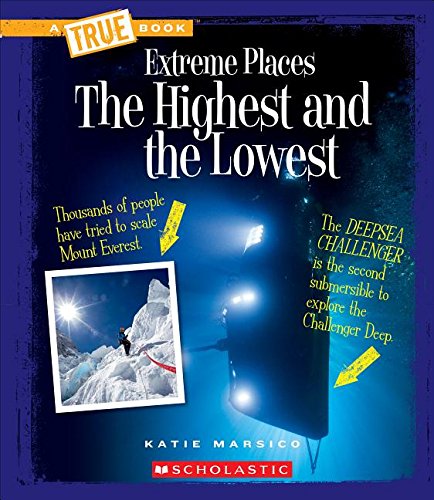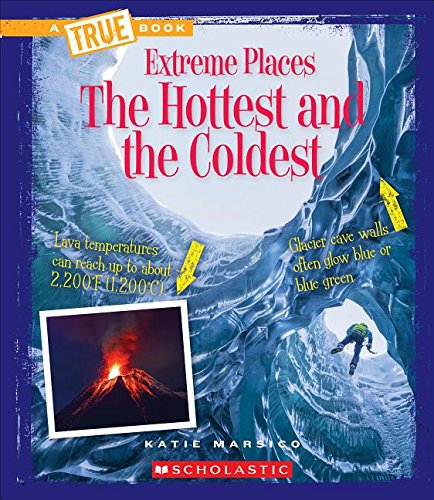-
The Highest and the Lowest
Katie Marsico
Paperback (Children's Press, Sept. 1, 2015)Learn about the lowest and highest points in the world.Mount Everest, towering more than 29,000 feet above sea level, is the highest point on Earth. However, if the mountain rose up from the planet's deepest point, in the Pacific Ocean's Mariana Trench, its peak would still be more than a mile below the surface! Readers(Grades 3-5) will learn all about the highest and lowest points on Earth, from what life is like in these extreme locations to how scientists and explorers travel dangerous routes to visit them. S
S
-
Extreme Weather
Ann O. Squire
Paperback (Children's Press, Sept. 1, 2014)Learn how scientists study some of the most extreme weather on Earth.Most days, you probably don't think too much about the weather. You might wear a coat on a cold day or carry an umbrella when it rains. But weather can be unpredictable. Downpours can flood entire cities, raging winds can knock down buildings, and huge piles of snow can block roads. Readers (Grades 3-5) will find out how scientists study some of the most extreme weather on Earth, from violent tornadoes to deadly hailstorms. They will also learn about some of the most devastating weather events in history. R
R
-
The Darkest and the Brightest
Katie Marsico
Paperback (Children's Press, Sept. 1, 2015)Can you imagine going several days without any sunlight? Or days where the sun never sets at all?Readers (Grades 3-5) will find out why these situations occur in certain places and how they can affect people's lives. They will also explore locations where the night sky is darkest and find out which places on Earth produce enough light to spot them from outer space. S
S
-
The Hottest and the Coldest
Katie Marsico
Paperback (Children's Press, Sept. 1, 2015)From the burning heat of Dharan, Saudi Arabia to the icy cold of Antarctica, temperatures on Earth can have extreme variation from place to place.Readers (Grades 3-5) will find out what life is like in these extreme places. They will also find out how conditions such as humidity and wind chill can affect the way extreme temperatures make us feel and learn how scientists study extreme temperatures in hard-to-reach areas such as ocean floors and mountaintops. S
S
-
The Wettest and the Driest
Katie Marsico
Paperback (Children's Press, Sept. 1, 2015)Some places on Earth experience seemingly nonstop rain, while others have gone hundreds of years without a single drop of precipitation.Readers (Grades 3-5)will find out why climates can be so different from one place to another, how extreme weather can cause natural disasters, and what effects precipitation can have on the natural landscape. They will also find out how people living in extremely wet or dry areas have adapted to the extreme weather of their homes. S
S
-
Tsunamis
Ann O Squire
Paperback (C. Press/F. Watts Trade, Jan. 15, 2016)Pushed ashore by powerful earthquakes and other geological events, tsunamis are fast-moving, gigantic waves with the strength and size to wipe out entire towns.Readers (Grades 3-5) will learn about some of history's most devastating tsunamis and find out why they caused so much damage. They will also learn how experts predict tsunamis and what people can do to protect against these deadly waves. S
S
-
Tornadoes
Steven Otfinoski
Paperback (C. Press/F. Watts Trade, Jan. 15, 2016)The powerful, twisting winds of a tornado can cause an incredible amount of damage in a very short time.These incredible storms have been known to overturn trucks and turn small, lightweight objects into deadly missiles. Readers (Grades 3-5) will learn how tornadoes form and get an up-close look at some of history's worst twisters. They will also learn how scientists study tornadoes and what people can do to protect themselves from cyclones. S
S
-
The Highest and the Lowest
Katie Marsico
Library Binding (Children's Press, Sept. 1, 2015)Learn about the lowest and highest points in the world.Mount Everest, towering more than 29,000 feet above sea level, is the highest point on Earth. However, if the mountain rose up from the planet's deepest point, in the Pacific Ocean's Mariana Trench, its peak would still be more than a mile below the surface! Readers(Grades 3-5) will learn all about the highest and lowest points on Earth, from what life is like in these extreme locations to how scientists and explorers travel dangerous routes to visit them. S
S
-
The Darkest and the Brightest
Katie Marsico
Library Binding (Children's Press, Sept. 1, 2015)Can you imagine going several days without any sunlight? Or days where the sun never sets at all?Readers (Grades 3-5) will find out why these situations occur in certain places and how they can affect people's lives. They will also explore locations where the night sky is darkest and find out which places on Earth produce enough light to spot them from outer space. S
S
-
The Hottest and the Coldest
Katie Marsico
Library Binding (Childrens Pr, Sept. 1, 2015)From the burning heat of Dharan, Saudi Arabia to the icy cold of Antarctica, temperatures on Earth can have extreme variation from place to place.Readers (Grades 3-5) will find out what life is like in these extreme places. They will also find out how conditions such as humidity and wind chill can affect the way extreme temperatures make us feel and learn how scientists study extreme temperatures in hard-to-reach areas such as ocean floors and mountaintops. S
S
-
The Wettest and the Driest
Katie Marsico
Library Binding (Childrens Pr, Sept. 1, 2015)Some places on Earth experience seemingly nonstop rain, while others have gone hundreds of years without a single drop of precipitation.Readers (Grades 3-5)will find out why climates can be so different from one place to another, how extreme weather can cause natural disasters, and what effects precipitation can have on the natural landscape. They will also find out how people living in extremely wet or dry areas have adapted to the extreme weather of their homes. S
S
-
Extreme Laboratories
Ann O. Squire
Paperback (Children's Press, Sept. 1, 2014)Labs give scientists the space and equipment they need to make their greatest discoveries.In order to maintain careful control over the safety and accuracy of their experiments, scientists often work in laboratories. Readers (Grades 3-5) will tour some of the world's most incredible laboratories, from the ocean research vessel that can flip from a vertical position to a horizontal one to the massive International Space Station. R
R